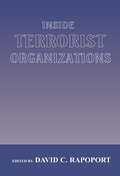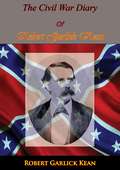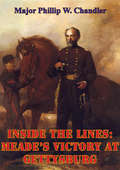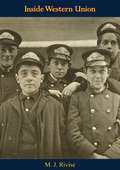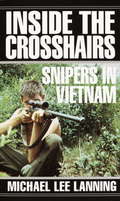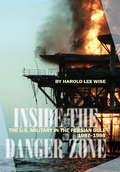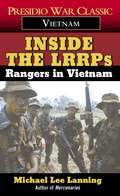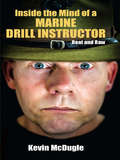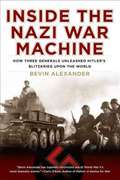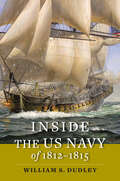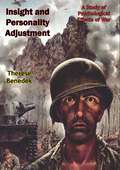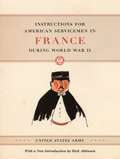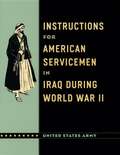- Table View
- List View
Inside Terrorist Organizations
by David C. RapoportThese original essays describe the internal life of terrorist organizations in fascinating detail. They show how no description of terrorist behaviour is adequate without a grasp of the deep tensions that often characterize such groups, and an appreciation of how firmly implanted in our culture terrorist traditions have become, since the middle of the nineteenth century.
Inside The Confederate Government: The Diary Of Robert Garlick Hill Kean, Head Of The Bureau Of War
by Dr Edward E. Younger Robert Garlick Hill KeanWhen the Civil War began, author Robert Garlick Hill Kean enlisted as a private. In 1862, his wife's uncle, George Wythe Randolph, took Kean on as his aide, and Kean followed him into the War Department at Richmond, where he became the head of the Confederate Bureau of War under John Archibald Campbell, the former U.S. Supreme Court justice. Kean's wartime diary, first published in 1957 and selected as Book-of-the-Month by the Civil War Book Club in May that same year, gives a vivid portrayal of every significant character, of both the military and civilian sectors, who comprised the highest levels of the Confederate government, and to this day is considered an indispensable resource for those seeking first-hand, in-depth discussion and analysis of the Richmond government.
Inside The Lines: Meade's Victory At Gettysburg
by Major Phillip W. Chandler USMCThe concepts of interior and exterior lines gained prominence during the Napoleonic Era with the writings of Jomini. Interior Lines of Operation deal with forces whose operations diverge from a central point. The use of interior lines allows a commander to rapidly shift forces to the decisive point.The Battle of Gettysburg was a great historical example illustrating the impact of interior and exterior lines. At the Battle of Gettysburg, the Confederates uncharacteristically fought along exterior lines. Their lines of communication stretched from Pennsylvania through the Shenandoah Valley south to Richmond. This was an extremely precarious situation for General Lee and weighed heavily on his decisions at Gettysburg.The Army of the Potomac, under command of newly appointed General Meade, found themselves operating from interior lines at Gettysburg. On July 2 and 3, this became a major factor in General Meade's ability to react to the offensive actions taken by the Army of Northern Virginia.I propose that Lines of Operations, as espoused by Jomini years earlier, was the decisive factor in the Gettysburg Campaign. I believe that the use of interior lines by General Meade, specifically throughout the day and night of Day 2 and again on day 3, allowed the Army of the Potomac to gain victory. The Army of Northern Virginia on several occasions achieved momentary breaks in the Union lines only to be repulsed by Union forces shifted from other positions. General Meade would not have been able to rapidly shift these forces to the decisive point unless he was operating on interior lines.Throughout the three days of battle, General Meade applied Operational Art in positioning his forces at the decisive time and place. One must keep in mind the significance of General Meade's actions at Gettysburg. He defeated the venerable General Robert E. Lee on the battlefield, a feat elusive to all previous commanders of the Army of the Potomac.
Inside The Third Reich
by Albert SpeerThe classic eye-witness account of Nazi Germany, by Hitler's Armaments Minister and right-hand man.'Inside the Third Reich is not only the most significant personal German account to come out of the war but the most revealing document on the Hitler phenomenon yet written. It takes the reader inside Nazi Germany on four different levels: Hitler's inner circle, National Socialism as a whole, the area of wartime production and the inner struggle of Albert Speer. The author does not try to make excuses, even by implication, and is unrelenting toward himself and his associates ... Speer's full-length portrait of Hitler has unnerving reality. The Führer emerges as neither an incompetent nor a carpet-gnawing madman but as an evil genius of warped conceits endowed with an ineffable personal magic' New York Times
Inside The Third Reich
by Albert SpeerThe classic eye-witness account of Nazi Germany, by Hitler's Armaments Minister and right-hand man.'Inside the Third Reich is not only the most significant personal German account to come out of the war but the most revealing document on the Hitler phenomenon yet written. It takes the reader inside Nazi Germany on four different levels: Hitler's inner circle, National Socialism as a whole, the area of wartime production and the inner struggle of Albert Speer. The author does not try to make excuses, even by implication, and is unrelenting toward himself and his associates ... Speer's full-length portrait of Hitler has unnerving reality. The Führer emerges as neither an incompetent nor a carpet-gnawing madman but as an evil genius of warped conceits endowed with an ineffable personal magic' New York Times
Inside Threat: A Novel
by Matthew Quirk"Quirk has earned his spot in the front ranks of thriller writers." — David BaldacciAn electrifying thriller from the author of The Night Agent now on Netflix, an attack on the White House sends the President and his top aides to take shelter in a top secret government facility buried deep underground—but they soon discover the threat is locked inside with them. Assume the worst. Code Black.The day that every secret service agent trains for has arrived. The White House has been breached; the President forced to flee to a massive doomsday bunker outside DC to defend against whatever comes next. Only the most trusted agents and officials are allowed in with him—those dedicated to keeping the government intact at all costs.Among these is Eric Hill, who has given his life to the Secret Service. They are his purpose and his family, and his impressive record has made him a hero among them. Despite his growing disillusionment from seeing Washington corruption up close, Eric can’t ignore years of instincts honed on the job. The government is under attack, and no one is better equipped to face down the threat than he is.The evidence leads him to a conspiracy at the highest levels of power, with the attack orchestrated by some of the very individuals now locked in with him. As the killers strike inside the bunker, it will take everything Eric Hill has to save his people, himself, and his country.Look for these other pulse-pounding thrillers by Matthew Quirk:Red WarningHour of the AssassinThe Night AgentDead Man Switch Cold Barrel Zero The Directive The 500
Inside Western Union
by M. J. RiviseRecalling the days before the advent of the internet and social media, when rapid written communication came not electronically, but electromechanically, Inside Western Union is a nostalgic collection of anecdotes by Mike Rivise, an experienced sales manager.In this fascinating book, first published in 1950, the author draws on his own experiences to with many tales of demanding customers who expected the most from their messenger boys, recalls stories of coded messages used to minimize word counts, and provides accounts of crooks that tried to wire the loot across town for later pick up.Rivise also includes details of the history of the Western Union company, including its early takeover by financier Jay Gould in 1881, its acquisition by American Telephone and Telegraph in 1909 following Gould’s death, the arrival of the competing service Postal Telegraph, and the invention of the telegraph by Samuel F. B. Morse, which revolutionised communication.An invaluable read!
Inside the Crosshairs
by Col. Michael Lee Lanning"The American sniper could be regarded as the greatest all-around rifleman the world has ever known. . . ."At the start of the war in Vietnam, the United States had no snipers; by the end of the war, Marine and army precision marksmen had killed more than 10,000 NVA and VC soldiers--the equivalent of an entire division--at the cost of under 20,000 bullets, proving that long-range shooters still had a place in the battlefield. Now noted military historian Michael Lee Lanning shows how U.S. snipers in Vietnam--combining modern technology in weapons, ammunition, and telescopes--used the experience and traditions of centuries of expert shooters to perfect their craft. To provide insight into the use of American snipers in Vietnam, Lanning interviewed men with combat trigger time, as well as their instructors, the founders of the Marine and U.S. Army sniper programs, and the generals to whom they reported. Backed by hard information and firsthand accounts, the author demonstrates how the skills these one-shot killers honed in the jungles of Vietnam provided an indelible legacy that helped save American lives in Grenada, the Gulf War, and Somalia and continues to this day with American troops in Bosnia.
Inside the Danger Zone
by Harold Lee WiseFrom the Iraqi attack on the USS Stark to Iranian mine fields to Revolutionary Guard gunboats, the 1987-88 Persian Gulf was a place of shadowy danger for U.S. Navy ships assigned to protect oil tankers during the Iran-Iraq War. A low-profile escort mission quickly became an international test of wills between the United States and Iran. The conflict escalated to involve secret missions and special operations until finally the United States and Iran engaged in open combat, most notably during Operation Praying Mantis in April 1988, the world's largest sea-air battle since World War II.It was the largest deployment of American forces between the Vietnam War and Desert Storm and one with dramatic implications for subsequent events. Yet, the story remained mostly untold and misunderstood for almost two decades. Inside the Danger Zone is the first book ever published to focus on this period, a fourteen-month span that saw an unprecedented series of American military action in this volatile region.Based on declassified documents and extensive interviews with veterans and government officials, many of which spoke out for the first time, Inside the Danger Zone is a fast moving narrative history that tells the story of this quasi-war with Iran from the White House to the front lines.
Inside the French Foreign Legion: Adventures with the World's Most Famous Fighting Force
by N. J. ValldejuliUnique among the world's fighting forces, the Legion remains one of its most mysterious, as well. Open to volunteers from around the world (men from some 150 countries fill its ranks), the Legion boasts an illustrious and exciting military history stretching from Europe to Africa and Latin America, from Vietnam and Algeria to Afghanistan; features a notoriously difficult selection and training process, accepting only 10 percent of applicants; and has traditionally required soldiers to enlist under assumed names. Soldiers swear allegiance not to France, but to the Legion, which has been romanticized in literature, song, and action movies as a place for men to prove their mettle or start their lives over. In this colorful, highly readable book, a blend of firsthand experience and interviews with former legionnaires, Nick Valldejuli gives an insider's perspective on what it means - and what it takes - to be a Légionnaire.Valldejuli, an English-born American who spent two years in the Legion, lifts the veil on who legionnaires are, what they do, where they serve, why they joined, and why they&’re willing to die for France, which for most is a foreign country. Stories move from Algeria in the 1960s and the Balkans in the 1990s to more recent French operations in Afghanistan and former colonies in Africa. Drawing on his own experiences as well as those of members from various countries over the past fifty years (including several girlfriends of soldiers), his stories highlight the Legion&’s intense camaraderie and its members&’ fierce loyalty to this unique unit, in addition to the extreme mental and physical demands made of them, and the sacrifices of their families back home.
Inside the Hot Zone: A Soldier on the Front Lines of Biological Warfare
by Mark G. KortepeterInside the Hot Zone is an insider&’s account of one of the most dangerous workplaces on earth: the United States Army Medical Research Institute of Infectious Diseases (USAMRIID) in Fort Detrick, Maryland. Retired U.S. Army Col. Mark G. Kortepeter, a leading biodefense expert, recounts his journey from the lecture hall to the role of department chief, to the battlefield, to the Biosafety Level-4 maximum containment lab, and finally, to the corner office. During Kortepeter&’s seven and a half years in leadership at USAMRIID, the United States experienced some of the most serious threats in modern germ warfare, including the specter of biological weapons during the Iraq War, the anthrax letters sent after 9/11, and a little-known crisis involving a presumed botulism attack on the president of the United States. Inside the Hot Zone is a shocking, frightening eye-opener as Kortepeter describes in gripping detail how he and his USAMRIID colleagues navigated threats related to anthrax, botulism, smallpox, Lassa, and Ebola. Kortepeter crafts a rich and riveting narrative as he wrestles with life-and-death decisions managing biological weapon exposures. The stories are real, but they could just as easily serve as plotlines in popular fiction or Hollywood thrillers. He gives the reader a seat at the table as each crisis unfolds, with an unvarnished and personal perspective on the dangers, the drama, the fear, the frustrations, the irony, and the uncertainty he encountered as a physician in the role of &“Biodefender.&”
Inside the LRRPs: Rangers in Vietnam
by Michael Lee LanningVietnam was a different kind of war, calling for a different kind of soldier. The LRRPs--Long Range Reconnaissance Patrols--were that new breed of fighting man. They operated in six-man teams deep within enemy territory, and were the eyes and ears of the units they served. This is their story--of perseverance under extreme hardship and uncommon bravery--and how they carried out the war's most hazardous missions.
Inside the Mind of a Marine Drill Instructor: Real and Raw
by Kevin McDugleInside the Mind of a Marine Drill Instructor is a book that takes you inside the life of Marine Corps Drill Instructor Kevin McDugle. Many fiery moments in recruit training leave lasting impressions for years to come on both the Drill Instructor and the sloppy recruit. Kevin McDugle is just one of the many Drill Instructors who can tell stories of taking lackadaisical civilians and turning them into war-fighting Marines. Inside the Mind of a Marine Drill Instructor is a compilation of those intense and insightful stories by Kevin McDugle. Kevin McDugle served in the Marines from 1988 until 1996. Kevin served in security forces at Bangor, Washington, with 1st Battalion 8th Marines, 2nd ANGLICO and as a Drill Instructor at Paris Island, South Carolina. Kevin is an entrepreneur, inventor and family man. You can read more about Kevin McDugle by visiting kevinmcdugle.com.
Inside the Nazi War Machine: How Three Generals Unleashed Hitler's Blitzkrieg Upon the World
by Bevin AlexanderIn 1940, as Hitler plotted to conquer Europe, only one nation posed a serious threat to the Third Reich's domination: France. The German command was wary of taking on the most powerful armed force on the continent. But three low-ranking generals-Eric von Manstein, Heinz Guderian, and Erwin Rommel-were about to change the face of modern warfare.By grouping tanks into juggernauts to slam through enemy lines, the blitzkrieg was born. With this aggressive, single-minded plan, the Nazis bypassed the supposedly impenetrable Maginot Line, charged into the heart of France, and alerted the world that the deadly might of Germany could no longer be ignored.
Inside the US Army
by Gordon Rottman Ronald VolstadWhen conscription was eliminated in the early 1970s, the US Army found itself with a very different kind of soldier. While the personality of the Army remained the same, the organization of its higher levels of command and combat formations, and the internal structure of its units underwent major changes under the 'Army of Excellence' program of the 1980s. This book explores the US Army of the late 80s, including the training methods, weapon systems, Reserve Components, organization and uniforms of one of the world's most potent fighting forces. The text is illustrated with numerous photographs and eight colour plates.
Inside the US Navy of 1812–1815 (Johns Hopkins Books on the War of 1812)
by William S. DudleyWhat did it take—logistically and operationally—for the small and underfunded US Navy to face the battle-hardened Royal Navy in the War of 1812? Find out in this book, the magnum opus of one of the deans of American naval history.When the War of 1812 broke out, the newly formed and cash-strapped United States faced Great Britain, the world's foremost sea power, with a navy that had largely fallen into disrepair and neglect. In this riveting book, William S. Dudley presents the most complete history of the inner workings of the US Navy Department during the conflict, which lasted until 1815. What did it take, he asks, for the US Navy to build, fit-out, man, provision, and send fighting ships to sea for extended periods of time during the War of 1812?When the British blockade of 1813–14 severely constrained American sea trade, reducing the government's income and closing down access to American seaports, the navy was forced to innovate: to make improvements through reforms, to redeploy personnel, and to strengthen its industrial capacity. Highlighting matters of supply, construction, recruitment, discipline, medical care, shipbuilding, and innovation, Dudley helps readers understand the navy's successes and failures in the war and beyond. He also presents the logistics of the war in relation to fleet actions on the lakes and selected ship actions on the oceans, stresses the importance of administration in warfighting, and shows how reforms and innovations in those areas led to a stronger, more efficient navy. Refuting the idea that the United States "won" the war, Dudley argues that the conflict was at best a stalemate. Drawing on twenty-five years of archival research around the world, Inside the US Navy of 1812–1815 will leave readers with a better appreciation of how the navy contributed strategic value to the nation's survival in the conflict and assisted in bringing the war to an honorable end. This book will appeal to scholars and students of naval and military history, veterans, current officers, and maritime-oriented history buffs.
Inside the VC and the NVA: The Real Story of North Vietnam's Armed Forces
by Michael Lee LanningIf the costs of the Vietnam War were great to Americans and staggering to the South Vietnamese, they were even worse for the North. And those costs were borne largely by the individual soldiers—the soldiers who won the war.<P> Based on interviews, soldiers’ diaries, letters, and government documents, this book, first published in 1992, gives a classic, soldier’s-eye account of the war our opponents fought and the men who fought it.
Inside the Vatican of Pius XII: The Memoir of an American Diplomat During World War II
by Harold H. Tittmann IIIAn invaluable contribution to the history of the Catholic Church during the Second World War, this is a richly detailed eyewitness account of the life and politics of the Vatican by an American who worked there from 1940 to 1944. The question of whether Pius XII and the Vatican must bear blame for failing to act decisively in response to Hitler's Final Solution is as hotly debated today as in the years directly following World War II. INSIDE THE VATICAN OF PIUS XII presents for the first time the obse...
Inside the Wire: A Military Intelligence Soldier's Eyewitness Account of Life at Guantanamo
by Erik Saar Viveca NovakDescribes in vivid detail the conditions and treatment.
Insider Threat: Military Romantic Suspense (The Echo Platoon Series #5)
by Marliss MeltonWhen a Navy Seal is Suspected of Leaking Secrets to North Korea, FBI Special Agent Kelly Yang Investigates in Insider Threat, a Military Romantic Suspense from Marliss Melton.--Present Day - Virginia Beach, VA--Navy SEAL Chuck Suzuki has lived a lie for years; now it’s time for redemption. But choosing Team and Country over ties of loyalty going back decades proves more dangerous than his work as a SEAL. Of all the times for Chuck to meet the woman of his dreams—this has got to be the worst.Katy Tang isn’t who she seems. She’s really FBI Special Agent Kelly Yang, on her first undercover assignment to befriend a suspected traitor. Stunned by her attraction to the Navy SEAL spy, she knows she’s about to be tested in ways she never imagined. The Echo Platoon SeriesDanger CloseHard LandingFriendly FireHot TargetInsider Threat
Insight and Personality Adjustment: A Study of Psychological Effects of War
by Therese BenedekSudden changes in the social scene, upheavals such as are wrought by economic depression, by revolutions and by wars, lay bare for our observation the interaction between the individual and society; they expose sharply the individual and his relationship to his primary social unit: the family. The war, with the shocklike interruption of the usual tempo of living, wrote a new, clearly defined chapter in the life of the individual as well as of the nation. And the family bears the brunt of the upheaval. Sociologists as well as psychiatrists look upon the family with concern. Will the family—this proven institution of many tasks—be able to carry on and continue to conserve our cultural inheritance, conveying it to a new, rebellious generation? Will it be able, at the same time, to keep step with the progress which our complex society impatiently forces upon its traditions?Impressed by the impact of the war upon the population, the psychiatrist had endless opportunities to study and interpret its effects upon human relationships. For the war exposed the images, illusions, expectations and disappointments which each of us harbors as indelible impressions of living together. Thus conflicts which already might have receded into inactivity during the routine of peacetime living were stirred into consciousness and demanded attention.
Inspectors for Peace: A History of the International Atomic Energy Agency (Johns Hopkins Nuclear History and Contemporary Affairs)
by Elisabeth RoehrlichThe first comprehensive, empirically grounded, and independent study of the history of the IAEA.The International Atomic Energy Agency, which sends inspectors around the world to prevent states from secretly developing nuclear bombs, has one of the most important jobs in international security. At the same time, the IAEA is a global hub for the exchange of nuclear science and technology for peaceful purposes. Yet spreading nuclear materials and know-how around the world bears the unwanted risk of helping what the agency aims to halt: the emergence of new nuclear weapon states. In Inspectors for Peace, Elisabeth Roehrlich unravels the IAEA's paradoxical mission of sharing nuclear knowledge and technology while seeking to deter nuclear weapon programs. Founded in 1957 in an act of unprecedented cooperation between the Cold War superpowers, the agency developed from a small technical bureaucracy in war-torn Vienna to a key organization in the global nuclear order. Roehrlich argues that the IAEA's dual mandate, though apparently contradictory, was pivotal in ensuring the organization's legitimacy, acceptance, and success. For its first decade of existence, the IAEA was primarily a scientific and technical organization; it was not until the Treaty on the Non-Proliferation of Nuclear Weapons entered into force in 1970 that the agency took on the far-reaching verification and inspection role for which it is now most widely known. While the Fukushima nuclear disaster and the Iran negotiations made the IAEA's name famous, the organization's remarkable history remains strikingly absent from public knowledge. Drawing on extensive archival research, including firsthand access to newly opened records at the IAEA Archives in Vienna, Inspectors for Peace provides the first comprehensive, empirically grounded, and independent study on the history of the IAEA. Roehrlich also interviewed leading policymakers and officials, including Hans Blix and Nobel Peace laureate Mohamed ElBaradei, the agency's former heads. This book offers insight not only for students, scholars, and policy experts but for anyone interested in the history of the nuclear age, the Cold War, and the role of international organizations in shaping our world.
Instructions for American Servicemen in France during World War II
by United States Army“A culturally sensitive and practical work, albeit one that pertains to the highly specific scenario of traveling through France immediately after D-Day.” —Nick Greene, Mental FlossWritten by anonymous War Department staffers to meet the urgent needs of the moment, with no thought of its historical value, Instructions for American Servicemen in France during World War II nevertheless brings to vivid life the closing years of World War II—when optimism was growing, but a long, demanding road still lay ahead.After lying unseen in Army archives for decades, this remarkable guide is now available in a new facsimile edition that reproduces the full text and illustrations of the original along with a new introduction by Rick Atkinson setting the book in context.Written in a straightforward, personal tone, the pamphlet is equal parts guidebook, cultural snapshot, and propaganda piece. A central aim is to dispel any prejudices American soldiers may have about the French—especially relating to their quick capitulation in 1940. Warning soldiers that the defeat “is a raw spot which the Nazis have been riding” since the occupation began, Instructions is careful to highlight France’s long historical role as a major U.S. ally. Following that is a brief, fascinating sketch of the French character (“The French are mentally quick;” “Rich or poor, they are economical”) and stark reminders of the deprivation the French have endured under occupation. Yet an air of reassuring confidence pervades the final section of the pamphlet, which reads like a straightforward tourists’ guide to Paris and the provinces—like a promise of better days to come once the soldiers complete their mission.
Instructions for American Servicemen in Iraq during World War II
by United States Army“American success or failure in Iraq may well depend on whether the Iraqis like American soldiers or not.” The U.S. military could certainly have used that bit of wisdom in 2003, as violence began to eclipse the Iraq War’s early successes. Ironically, had the Army only looked in its own archives, they would have found it—that piece of advice is from a manual the U.S. War Department handed out to American servicemen posted in Iraq back in 1943. The advice in Instructions for American Servicemen in Iraq during World War II,presented here in a new facsimile edition, retains a surprising, even haunting, relevance in light of today’s muddled efforts to win Iraqi hearts and minds. Designed to help American soldiers understand and cope with what was at the time an utterly unfamiliar culture—the manual explains how to pronounce the word Iraq, for instance—this brief, accessible handbook mixes do-and-don’t-style tips (“Always respect the Moslem women.” “Talk Arabic if you can to the people. No matter how badly you do it, they will like it.”) with general observations on Iraqi history and society. The book’s overall message still rings true—dramatically so—more than sixty years later: treat an Iraqi and his family with honor and respect, and you will have a strong ally; treat him with disrespect and you will create an unyielding enemy. With a foreword by Lieutenant Colonel John A. Nagl reflecting on the manual’s continuing applicability—and lamenting that it was unknown at the start of the invasion—this new edition of Instructions for American Servicemen in Iraq will be essential reading for anyone who cares about the future of Iraq and the fate of the American soldiers serving there.
Instructions for His Generals
by Gen. Thomas R. Phillips Frederick The GreatThe king of Prussia from 1740 to 1786, Frederick the Great ranks among eighteenth-century Europe's most enlightened rulers. In addition to abolishing serfdom in his domains and promoting religious tolerance, he was an ardent patron of the arts and an accomplished musician. "Diplomacy without arms," he observed, "is like music without instruments." Frederick's expertise at military matters is reflected in his successful defense of his territory during the Seven Years' War, in which he fought all the great powers of Europe. His brilliant theories on strategy, tactics, and discipline are all explained in this vital text."War is not an affair of chance," Frederick asserted, adding that "a great deal of knowledge, study, and meditation is necessary to conduct it well." In this book, he presents the fundamentals of warfare, discussing such timeless considerations as leadership qualities, the value of surprise, and ways to conquer an enemy who possesses superior forces. The soundness of his advice was endorsed by Napoleon himself, who once advised, "Read and re-read the campaigns of Alexander, Hannibal, Caesar . . . and Frederick. This is the only way to become a great captain and to master the secrets of the art of war."
